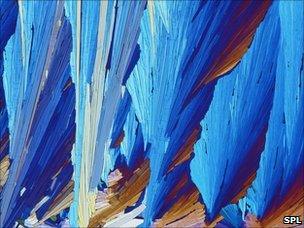Gene variations may have breast cancer role, team says
- Published

Crystals of estradiol, the most potent of the six naturally-occurring oestrogens
Researchers say they have identified a series of gene variations which together may play a role in the development of a common breast cancer.
A study of women in Finland and Sweden linked the variations to the production of oestrogen.
The hormone is known to play a role in a type of breast cancer which afflicts post-menopausal women.
The researchers say the findings might be used to identify women who might benefit from oestrogen-lowering drugs.
Poker hand
The researchers examined the genetic makeup of thousands of women with and without breast cancer in Sweden and Finland.
They found 121 tiny variations in 15 different genes which they say appear to be linked to a woman's risk of developing what is known as oestrogen receptor positive breast cancer.
The variations are in a section of DNA close to a gene responsible for producing oestrogen and the suggestion is that the variations may play a collective role in the production of the female sex hormone.
The individual impact of each variation is minimal but if a woman is dealt a combination of these variations, say the scientists, the higher her exposure to the hormone will be, and the higher the risk of cancer.
"Breast cancer genes have been identified, for example BRCA1, BRCA2, P53, ATM. These genes have been identified with breast cancer susceptibility but mainly in breast cancers of younger women," says Dr Edison Liu of the Genome Institute of Singapore, who led the study.
"What we are finding here is potentially the genetic amplifiers for breast cancer in postmenopausal women which historically was considered not genetic in origin."
It is already established that women who start menstruating early in life or who have a late menopause have an increased risk of breast cancer, because of their longer exposure to oestrogen. This research, says Dr Liu, may reveal the genetic element to the oestrogen equation.
"It's like being dealt a bad hand in a poker game," he says. "And this risk is greatly affected by other non-genetic factors like a woman's reproductive history," he says.
Known remedy
Dr Liu says that while the results will require further validation, the sample is large and the outcomes were significant. They have also detected the same genetic variations in women with cancer of the uterus where oestrogen exposure is also considered key.
Should the results be confirmed by further studies, he says the work could be used to identify women who carry a combination of these genetic variants, and who may benefit from existing oestrogen-lowering drugs to reduce the cancer risk.
"We're moving closer and closer to personalised and tailored medicines," he says. "Ultimately, we may be able to tailor oestrogen exposure up and down to optimise health and minimise risk."
Nell Barrie, science communications officer at Cancer Research UK, said: "We know that oestrogen levels play an important role in the development of breast and womb cancers.
"This research brings us a step closer to understanding the many subtle genetic changes that interact to affect individual women's risk of these diseases. Studying these changes should help to identify women most at risk so they can be offered tailored advice, screening and treatments in the future."
Details of the research are being unveiled today at the British Society for Human Genetics Annual Conference, which is being held in Warwick.